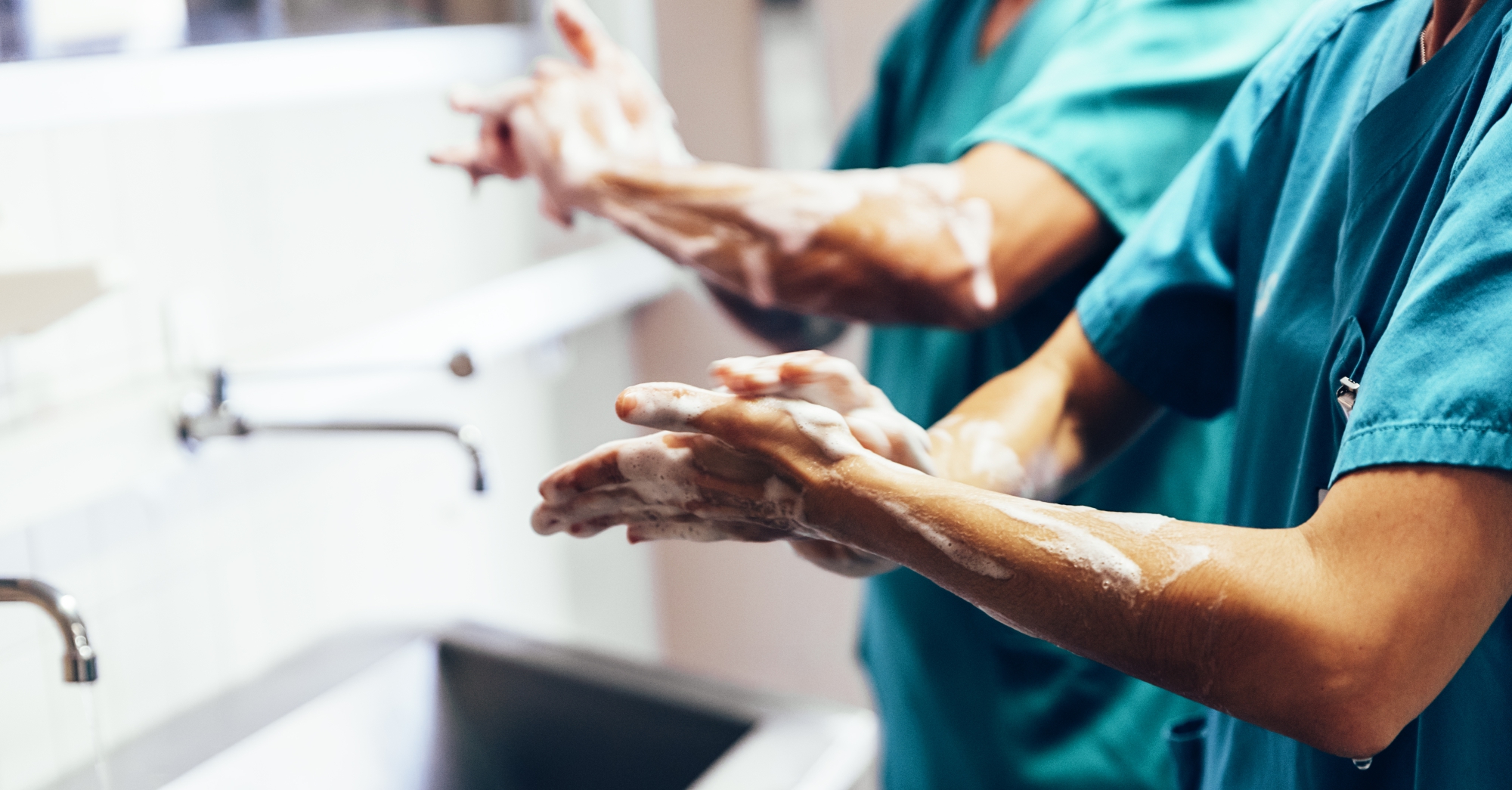
Preventing Surgical Infections: Identifying the “Best” Interventions

Preventing Surgical Infections: Identifying the “Best” Interventions
Vol: | Issue: | Number: | ISSN#: 2563-5972
July 9, 2021 | Article No. 60

Preventing Surgical Infections: Identifying the “Best” Interventions
July 9, 2021 | Article No. 89
Ayesha Siddiqua MSc, PhD
Mohit Bhandari MD, PhD

Dr. Parvizi is a board certified orthopaedic surgeon specializing in pelvis, hip, and knee reconstruction with a special interest in hip pain in young adults and joint preservation procedures. He is the director of Clinical Research at the Rothman Orthopaedics.
Dr. Parvizi brings a new and unique expertise for treatment of hip pain in young adults, which includes Ganz's Periacetabular Osteotomy and other non-replacement surgeries for the hip.
Insights
- Despite many advancements in the field of surgery, surgical site infections (SSIs) remain a major public health concern.
- There are 3 main types of SSIs: superficial incisional SSI, deep incisional SSI, organ or space SSI.
- A wide range of patient, surgery, and hospital risk factors can predispose individuals to an SSI.
- Even though there are several guidelines related to prevention of SSI, some recommendations have been subject to criticism.
- Many evidence-based interventions with proven efficacy to prevent SSI remain underutilized.
- We share a 10 step approach for preventing SSIs based on evidence and surgeon experience in the field for the OE community to consider.

“Surgical site infections (SSIs) are infections of the incision or organ or space that occur after surgery. Surgical patients initially seen with more complex comorbidities and the emergence of antimicrobial-resistant pathogens increase the cost and challenge of treating SSIs. The prevention of SSI is increasingly important as the number of surgical procedures performed in the United States continues to rise…it has been estimated that approximately half of SSIs are preventable by application of evidence-based strategies.”
Berríos-Torres et al (2017) (1)
With the advent of many innovations over the years, there have been great improvements in the field of surgery. In fact, there have been some global advances that have elevated the safety and efficacy of all surgeries, leading to a complete revolutionization of this field. Notably, with the turn of the 19th century, there have been two main paradigm shifts in the history of surgery (See our OE World Tour session “Why do people die after surgery: New Insights” for more details). In the early days, deaths after surgery due to infections were common as there was still a lack of understanding of bacteria. Dr. Joseph Lister played a seminal role in introducing the practice of sterile technique in surgery. According to historical accounts, Dr. Lister once left a cadaver room after practicing a surgery, went straight to the operating room and completed the surgery very quickly and sawed off his assistant’s finger by mistake. Later, both his patient and assistant ended up dying due to sepsis. This led him to ponder whether he was bringing something from the cadaver room, which in turn led him to be at the forefront of championing sanitary practices in surgery. These sanitary practices had a tremendous impact on improving the safety of surgery – just with washing hands, surgical mortality dropped from 46% to 15%. Many years have passed since the initial discoveries of Dr. Lister and even though many innovations have been integrated in surgery to reduce infections, with considerable decline in the prevalence of surgical site infections (SSIs) – it still very much remains as a significant public health concern. Recent estimates suggest that if you have a surgery, the chances of developing an SSI can range from 1% to 3% (2). While there are a wide range of interventions that are recommended during the preoperative, intraoperative, and postoperative period, there is a lack of consensus and considerable differences in interventions implemented across different settings. An overview of the different interventions, the caveats of their use, as well as new challenges in SSI prevention is critical for clinicians to decide which interventions are the most appropriate for them to use given their specific context of practice – to improve both patient and health system outcomes.

"Infections after surgery are caused by germs. The most common of these include the bacteria Staphylococcus, Streptococcus, and Pseudomonas. Germs can infect a surgical wound through various forms of contact, such as from the touch of a contaminated caregiver or surgical instrument, through germs in the air, or through germs that are already on or in your body and then spread into the wound."
Johns Hopkins Medicine (2021) (2)

“Connective tissue disease has been also correlated with increased risk for PJI (periprosthetic joint infection) after THA (total hip arthroplasty). This group of conditions, including rheumatoid arthritis (RA), systemic lupus erythematosus, and psoriatic arthritis, is associated with modulation of the patient’s immune system, resulting in predisposition to infection. Patients with longer duration of RA are at increased risk.”
“A number of other comorbidities have been also described as independent contributors to the infection risk after THA. These include preoperative anemia, liver disease, alcohol and intravenous drug abuse, previous myocardial infarction, congestive heart failure, postoperative atrial fibrillation, renal insufficiency, fluid and electrolyte disorders, and pulmonary circulatory disease.”
Triantafyllopoulos et al (2015) (3)
A Primer on Surgical Site Infections
The Centers for Disease Control and Prevention (CDC) describe 3 different types of SSI (Exhibit 1). While there are some common signs and symptoms associated with any SSI, such as redness, delayed healing, fever, pain, tenderness, warmth, or swelling, there are signs and symptoms specific to the SSIs as well (Exhibit 1). Furthermore, the level of risk for an SSI is also associated with the type of surgical wounds (Exhibit 2), as well as a wide range of patient, surgical, and hospital risk factors (Exhibit 3). Many of the risk factors that increase the risk of SSI are modifiable and present important areas of intervention to reduce complications experienced by patients as well as healthcare costs.
Exhibit 1: Description of Surgical Site Infections (2)
| SSI Type | Description | Signs and symptoms |
| Superficial incisional SSI | These infections occur just in the skin area where the incision was made | Production of pus from the wound site Samples from pus can be grown in culture to determine the types of germs causing the infection |
| Deep incisional SSI | These infections occur beneath the incision area and into the muscles as well as the tissues surrounding the muscles | Production of pus from wound site Wound site may reopen on its own Surgeon may reopen the wound and find pus inside |
| Organ or space SSI | These infections can occur in any area of the body, excluding the skin, muscle, surrounding tissues involved in the surgery | There may be discharge of pus coming from a drain placed into the skin through a body space or organ An abscess (an enclosed area of pus and disintegrating tissue surrounded by inflammation) may be seen when wound is reopened or examined by special X-rays |
Exhibit 2: Type of Surgical Wound (2)
| Type of wound | Description |
| Clean wound | Not inflamed or contaminated; does not involve internal organ surgery |
| Clean-contaminated wound | Involves internal organ surgery; no infection at the time of surgery |
| Contaminated wound | Involves internal organ surgery; there is content spillage from the organ into the wound |
| Dirty wound | Infection is present at the time of surgery |
Exhibit 3: Patient, Surgical, and Hospital Risk Factors for Surgical Site Infections (2-4)
| Patient risk factors | • Older age • Existing infection • Low serum albumin concentration • Comorbidities • Diabetes • Malnutrition • Smoking • Obesity • Rheumatoid arthritis • Human Immunodeficiency Virus (HIV) • Poor oral health • Patients at risk for methicillin-resistant Staphylococcus Aureus (MRSA) • Physiological states including trauma, shock, blood transfusion, hypothermia, hypoxia, and hyperglycemia |
| Surgical risk factors | • Inadequacies in surgical scrub or the antiseptic preparation of the skin • Allogeneic blood transfusion • Receiving low molecular weight heparin (LMWH) for DVT prophylaxis • Longer surgery time • Not adhering to protocols of prophylactic antibiotic administration |
| Hospital risk factors | • Longer hospitalization • Low institution volume of THA procedures • Low surgeon volume of THA procedures |
A Snapshot of the Cost of Infections

“With an estimated 27 million surgical procedures each year, approximately 300,000–500,000 SSI can be predicted to occur annually. They are believed to increase the risk of dying 2–11 fold, with 77% of these deaths attributed directly to the infection. Furthermore, a mean attributable increase of 7–10 days of postoperative hospitalization leads to higher costs, including additional annual health care expenditures ranging from $1–10 billion.”
Hranjec et al (2010) (5)

“There have been some papers that suggest having a periprosthetic joint infection can be as medically challenging to the patient as having cancer, and so it is not something we should take lightly…obviously, we can successfully get a lot of people through surgery and even a high-risk patient may have only a 3% or 4% chance of having an infection; but, if that patient gets an infection, it is 100% detrimental to them.”
Dr. Jeremy M. Gililland,
Assistant Professor of Orthopedic Surgery,
University of Utah (6)

“In low- and middle-income countries, 11% of patients who undergo surgery are infected in the process. In Africa, up to 20% of women who have a caesarean section contract a wound infection, compromising their own health and their ability to care for their babies.”
World Health Organization (2016) (7)
Interventions to Prevent Infections

“Many studies show that implementing a range of preventive measures significantly reduces harm from surgical site infections. A pilot study in 4 African countries showed that implementing a selection of the new recommendations could result in a 39% reduction in surgical site infections.”
World Health Organization (2016) (7)

“CDC has recently come out with guidelines that say you only need one dose of antibiotics and it is creating a lot of controversy because many thought that recommendation is based on either flawed data or data that were not applicable to joint replacement patients.”
Dr. Bryan D. Springer,
OrthoCarolina Hip and Knee Center (6)
Although there has been a significant amount of research examining a wide range of preoperative, intraoperative, and postoperative interventions to prevent SSIs, it should be noted that for many years, there were no international evidence-based guidelines to inform clinician decisions, and there remains inconsistencies in the interpretation of evidence and recommendations in current national guidelines (7). In 2016, the WHO published a set of guidelines that were proposed to be “valid for any country and suitable to local adaptations, and (took into account) the strength of available scientific evidence, the cost and resource implications, and patient values and preferences” (7). In 2018, the WHO published the second edition of these guidelines that can also be adapted to local contexts as needed. However, there has been considerable discussion regarding the shortcomings of guidelines from prominent governing bodies to prevent SSI, including the WHO and CDC. For example, Hedenstierna et al. (2019) published a critical analysis of the relevant evidence and highlighted the lack of empirical support of recommendations from the WHO and the CDC for surgical patients to receive an increased oxygen concentration during and after surgery (8).
Notwithstanding the varying levels and quality of evidence that support different recommendations to prevent SSI, as well as the varying levels of endorsement of these recommendations by different clinicians and research groups, the breadth of interventions available is important to review as they remain part of clinical practice – albeit at different extent in different contexts. In the following sections, we provide a high-level summary of a wide range of preoperative, intraoperative, and postoperative interventions to prevent SSI, adapted based on recommendations from recent guidelines (9). It has been noted that many interventions to prevent SSI remain underutilized despite support from a large body of evidence indicating their efficacy (5). Beyond the specific interventions, there have been calls for a shift in care model that aims to minimize the occurrence of SSI. A wide range of recommendations have been made for a revitalized care model, including (5):
- Increased collaboration among physicians
- Better communication with operating room staff/teams
- Creating easy to follow standardized protocols
- Involving relevant departments to prevent errors (e.g., pharmacy)
Preoperative interventions
Preoperative bathing with soap (antimicrobial or non-microbial) is generally accepted to be a beneficial practice, however, there is a lack of evidence on the impact of preoperative bath on the incidence of SSIs. If hair removal is necessary, it is recommended that razors should be avoided to prevent cuts to the skin, which can lead to infection later, and an electrical clipper should be used instead. The use of MRSA screening, decolonization, contact precautions and vancomycin-containing antibiotic prophylaxis is supported as it leads to lower rates of SSI. Several other strategies to be implemented close to the time of surgery are also recommended, including:
- Cleaning surgical hand and forearms with antiseptic soap and water or alcohol-based hand rub before wearing sterile gowns and gloves
- Using alcohol based antiseptic skin preparation, unless contraindicated
- Administering prophylactic antimicrobials, when indicated, within 1 hour before surgery for all microbials except for vancomycin and fluoroquinolones, which should be administered 2 hours before surgery
- Single dose of surgical antimicrobial prophylaxis is sufficient in most cases but redosing can be necessary depending on the agent’s half life
Intraoperative interventions
Hypothermia has been associated with a risk of SSI and the use of warming devices to ensure perioperative normothermia is recommended. There is also support for using hemodynamic goal-oriented therapy to reduce SSI. Furthermore, it is recommended that antimicrobial agents should not be used to irrigate incisional wounds. The use of non-iodophor-impregnated drapes for surgery are not recommended. Recent high-level evidence demonstrates that the use of povidine-iodine based irrigation surgical irrigation solution is very effective in reduction of SSI/PJI (10-12). In a systematic review of 29,630 total joint arthroplasties in 29,596 patients (10 studies, one RCT, eight retrospective cohorts, and one case series), the pooled risk ratio for SSI in studies using povidone-iodine compared to saline was 0.62 (95% confidence interval [CI]: 0.33-1.19), while for chlorhexidine it was 0.74 (95%CI: 0.33-1.65) (13).
Postoperative interventions
There is a lack of high-quality evidence to support many postoperative wound management strategies to precent SSI. In general, individualized decisions are recommended when selecting dressing, depending patient and wound needs.

“Nearly half of post-surgical infections and more than a quarter of infections following chemotherapy are caused by organisms that are already resistant to standard prophylactic antibiotics in the United States.”
“(Findings of a modelling study) estimated that a 10% drop in efficacy of antibiotics could result in 40,000 additional infections each year, with a 70% drop in efficacy causing as many as 280,000 new infections. Infection-related deaths, meanwhile, could rise by between 2,100 and 150,000.”
Chipman (2015) (13)
New Challenges in Preventing Infections
The challenges of preventing SSIs do not only end at the lack of evidence for some interventions or the lack of implementation of interventions with proven benefits. Large clinical trials evaluating pre-operative, intra-operative and post-operative approaches are needed. Optimizing patient care and reducing infection risk following surgery requires large scale, pragmatic, and frugal innovations—if widespread adoption is the goal. Even though antibiotics are critical for preventing SSIs, the rise of antibiotic resistance is making this a more difficult goal to achieve. Additionally, surgical patients are now initially seen with increasingly more complex comorbidities, including a wide range of chronic and immunocompromising conditions (1,5). There are also greater numbers of elderly surgical patients and those with prosthetic implants and organ transplantation who require surgery and are particularly vulnerable to SSI (5).

“Efforts to prevent surgical site infection (SSI) employ methods that are valid scientifically, but each institution and each surgeon also incorporates methods believed to be useful although this has not been proved by clinical trials.”
Hranjec et al (2010) (5)
Insights: “My 10 Step Approach” Dr. Parvizi
It is paramount that we implement proven strategies that will minimize the risk of SSI/PJI. The International Consensus Meeting on Orthopedic Infections (www.icmphilly.com) voted on a series of measures that are proven to be effective in this regard. I personally have a ten step protocol that I have implemented in my practice. These measures are proven to be effective as the incidence of SSI/PJI among my patients, who are followed very carefully, remains under 0.5%, despite me operating on sicker patients. The ten step approach includes:
1) Preoperative optimization of patients: This is a very board, yet criterial element of SSI prevention. I ensure that patients have good oral health, good glycemic control (using fructosamine or HbA1C), no skin ulceration, are off immunocompromising medications, correction or anemia and so on.
2) Reduce bioburden: This step involves administration of preoperative cleansing agents, removing hair, decolonization of the nares and so on.
3) Antimicrobial: We have alluded to the importance of perioperative antimicrobial above. It is critical to mention that we need to administer the appropriate antibiotic (cephazolin), at appropriate time (within 30-60 minutes before surgery) and the correct dose. Cephazolin and vancomysin (if administered) need to be weight based.
4) Respect for soft tissues: This is one aspect of surgery that is not discussed as often. Being respectful to soft tissues by not malhandling them, tearing skin, or continuously touching the incision are extremely important aspects of surgery. We need to make an incision that is as small as possible but large enough to allow us to perform the surgery safely.
5) Blood conservation: There is ample evidence to show that allogeneic blood transfusion increased the risk of subsequent SSI/PJI. Therefore, besides addressing anemia and correcting it preoperatively, if possible, we need to ensure that hypotensive (regional) anesthesia is applied, patients are given tranexamic acid, and bleeding from soft tissues are minimized.
6) Expeditious surgery: The longer a patient is on the operating table, the higher the likelihood of subsequent infections. Thus, I ensure that every surgical procedure is executed in an expeditious manner as possible.
7) Reduce OR traffic: Every person sheds bacteria. The more people in the OR, the higher the number of bacteria in the air and higher the likelihood for subsequent SSI. Do not let people just wonder in the OR. Only those who have a business to be in the OR need to be there.
8) Antispetic irrigation solution: Despite all our efforts, infective organisms do find their way into surgical incision. If the number of pathogens in the wound reaches and exceeds the host immune threshold (conceptual formula as proposed by the CDC), then an infection can arise. Thus, we need to ensure that pathogens are removed from the incision prior to closure. The best way to accomplish this is by using antiseptic irrigation solution. I use STERILE povidine-iodine irrigation solution as recommended by the CDC.
9) Clean Implants/Instruments: It is critical to ensure that all instruments used during surgery are properly cleaned and contamination of these instruments during surgery is avoided. I also do not touch the implants and do not allow them to come into contact with the skin during implantation either.
10) Proper Wound management: Besides respectful handling of soft tissues, I ensure that wound is properly closed (monofilament sutures and skin glue), appropriate wound dressing is applied (occlusive dressing), wound drainage is prevented (avoid aggressive anticoagulation and stick to aspirin), and so on.
Implementing these measures, or just paying attention to the fact that majority of SSIs/PJIs occur as a result of breach in “sterility” in the OR in itself provides great service to patients in avoiding this disastrous complication.
Contributors
References
1. Berríos-Torres SI, Umscheid CA, Bratzler DW, Leas B, Stone EC, Kelz RR, et al. Centers for Disease Control and Prevention Guideline for the Prevention of Surgical Site Infection, 2017. JAMA Surg. 2017 Aug 1;152(8):784.
2. Johns Hopkins Medicine. Surgical Site Infections [Internet]. [cited 2021 Jul 6]. Available from: https://www.hopkinsmedicine.org/health/conditions-and-diseases/surgical-site-infections
3. Triantafyllopoulos G, Stundner O, Memtsoudis S, Poultsides LA. Patient, Surgery, and Hospital Related Risk Factors for Surgical Site Infections following Total Hip Arthroplasty. The Scientific World Journal. 2015 May 14;2015:e979560.
4. Egol KA, Pagnano M, Iii PT, Springfield DS. An Instructional Course Lecture, American Academy of Orthopaedic Surgeons. JBJS. 2011 Feb 16;93-A(4):398-404.
5. Hranjec T, Swenson BR, Sawyer RG. Surgical Site Infection Prevention: How We Do It. Surg Infect (Larchmt). 2010 Jun;11(3):289–94.
6. Orthopedics Today. Take intraoperative steps to reduce joint infection risk [Internet]. [cited 2021 Jul 7]. Available from: https://www.healio.com/news/orthopedics/20171221/take-intraoperative-steps-to-reduce-joint-infection-risk
7. WHO recommends 29 ways to stop surgical infections and avoid superbugs [Internet]. [cited 2021 Jul 6]. Available from: https://www.who.int/news/item/03-11-2016-who-recommends-29-ways-to-stop-surgical-infections-and-avoid-superbugs
8. Hedenstierna G, Meyhoff CS, Perchiazzi G, Larsson A, Wetterslev J, Rasmussen LS. Modification of the World Health Organization Global Guidelines for Prevention of Surgical Site Infection Is Needed. Anesthesiology. 2019 Oct 1;131(4):765–8.
9. Ling ML, Apisarnthanarak A, Abbas A, Morikane K, Lee KY, Warrier A, et al. APSIC guidelines for the prevention of surgical site infections. Antimicrobial Resistance & Infection Control. 2019 Nov 12;8(1):174.
10. Cheng M-T, Chang M-C, Wang S-T, Yu W-K, Liu C-L, Chen T-H. Efficacy of dilute betadine solution irrigation in the prevention of postoperative infection of spinal surgery. Spine (Phila Pa 1976). 2005 Aug 1;30(15):1689–93.
11. Brown NM, Cipriano CA, Moric M, Sporer SM, Della Valle CJ. Dilute betadine lavage before closure for the prevention of acute postoperative deep periprosthetic joint infection. J Arthroplasty. 2012 Jan;27(1):27–30.
12. Calkins TE, Culvern C, Nam D, Gerlinger TL, Levine BR, Sporer SM, et al. Dilute Betadine Lavage Reduces the Risk of Acute Postoperative Periprosthetic Joint Infection in Aseptic Revision Total Knee and Hip Arthroplasty: A Randomized Controlled Trial. J Arthroplasty. 2020 Feb;35(2):538-543.e1.
13. Wood T, Ekhtiari S, Mundi R, Citak M, Sancheti PK, Guerra-Farfan E, et al. The Effect of Irrigation Fluid on Periprosthetic Joint Infection in Total Hip and Knee Arthroplasty: A Systematic Review and Meta-Analysis. Cureus. 12(4):e7813.
14. Chipman A. Antibiotic resistance threatens surgical procedures and chemotherapy, study warns [Internet]. The Pharmaceutical Journal. [cited 2021 Jul 7]. Available from: https://pharmaceutical-journal.com/article/news/antibiotic-resistance-threatens-surgical-procedures-and-chemotherapy-study-warns
© OrthoEvidence Inc. All Rights Reserved.




 LOGIN
LOGIN


